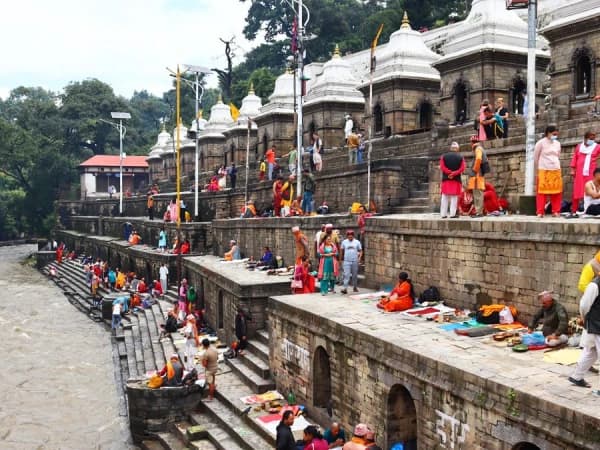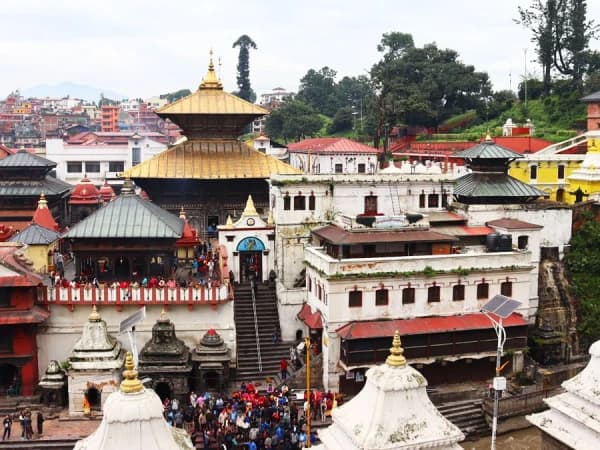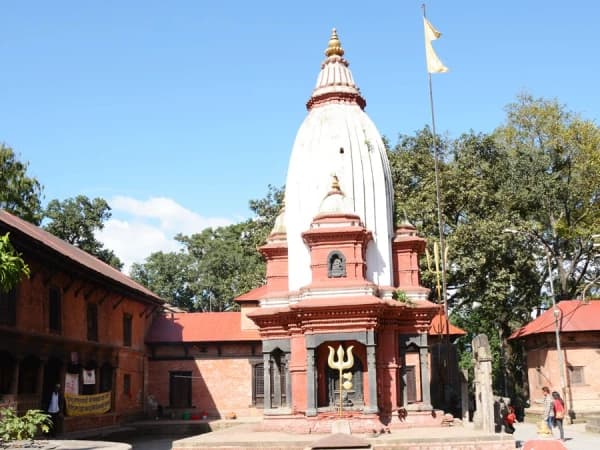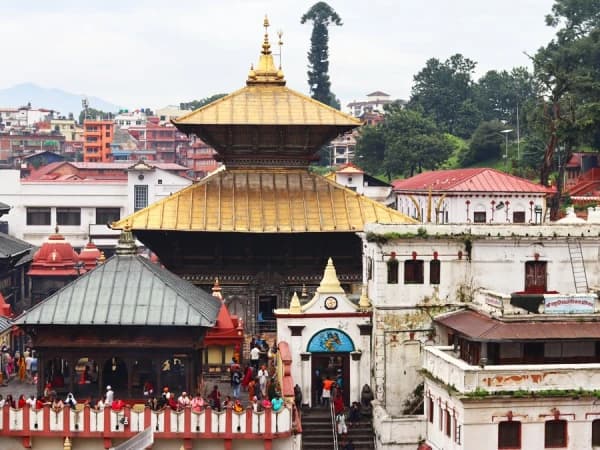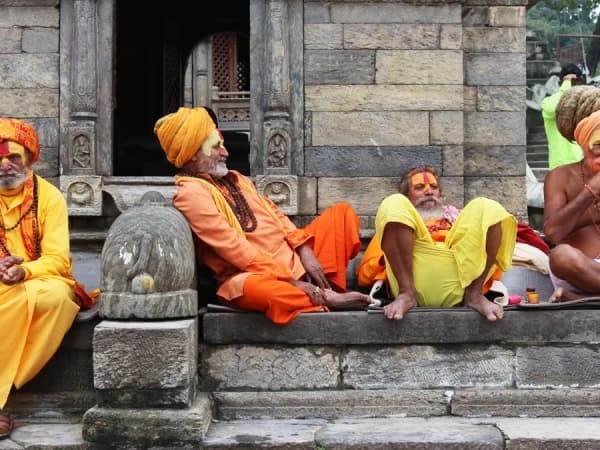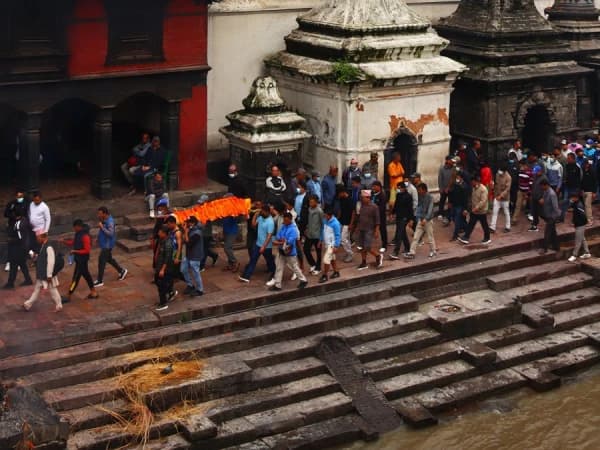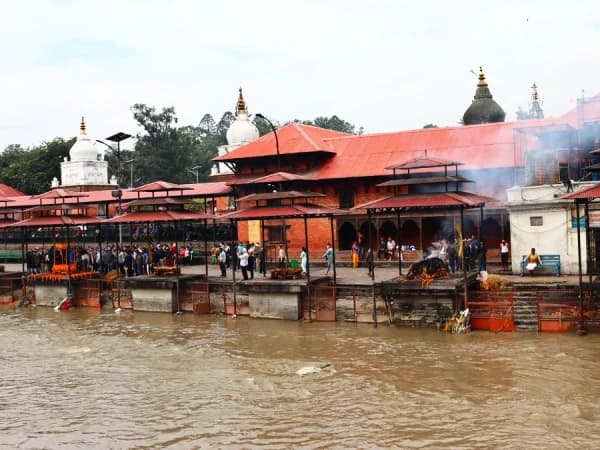Pashupatinath is a cornerstone of the Hindu Sanatan civilization, embodying the intrinsic philosophy that human life both begins and ends with its profound values. Revered as the supreme lord of time, space, and matter, Pashupatinath symbolizes infinity, with no beginning and no end. It governs creation through its roles of generation, operation, and destruction, earning the title Mahadev, the supreme God of gods.
The antiquity of Pashupatinath surpasses the Indus Valley Civilization, as evidenced by a seal depicting a meditating figure associated with Pashupatinath, discovered in the 1928 Mohenjodaro excavation in present-day India. Representing the integration of time, space, and matter, Pashupatinath manifests in nature through the five elements: air, earth, fire, sky, and water.
The temple is a spiritual nexus for various traditions, including Hinduism, Buddhism, Jainism, Saivism, Tantrism, Kirat, and other religious sects rooted in the region. Recognized as a UNESCO World Heritage Site in 1979, the temple stands in Kathmandu, Nepal, near Tribhuvan International Airport. Pilgrims, particularly Hindus and Buddhists, often begin their spiritual journeys in Kathmandu with a visit to Pashupatinath before engaging in other activities.
Monuments
Areas that embody cultural, historical, and civilizational significance within a natural setting are monumental zones. The integration of universal truths—generation, operation, and destruction—within cultural and natural values defines these monuments. The grand monumental zone of Pashupatinath exemplifies this synthesis. To fully grasp the essence of the Pashupat civilization, one must explore the various sacred monuments within this zone. These monuments collectively represent the profound cultural and spiritual heritage of Pashupatinath. Some of the most significant monuments in this sacred area are listed below:
Shree Pashupatinath
In South Asia, many names begin with the prefix "Shree," which symbolizes the Shree Yantra. "Shree" represents the blessings of knowledge, wealth, and power, personified by Saraswati, Laxmi, and Kali, respectively. The embodiment of nature's energy and the supreme lord of all life, Pashupatinath, is regarded as the God of gods.
Geological research reveals that the Kathmandu Valley was once a lake. The water drained out during the Paleolithic Age (approximately 250,000 to 10,000 years ago), after which Aryans from the south and Mongols from the north began migrating into the valley. Under the guidance of the sage Nemi, a cowherd captain named Bhuktaman was appointed as the first king of the land, giving rise to the name Nepal and marking the beginning of its monarchy.
According to legend, the godly cow Kamadhenu offered her milk daily in a specific area, prompting locals to excavate and uncover a radiant golden Shiva Lingam. This site later became the sanctum of the magnificent Shreepashupatinath temple. In 433 CE, Lichhavi king Supushpadev, also known as Prachandadev, constructed the awe-inspiring temple that stands to this day.
In Tantrism, the Shree Yantra embodies nine dimensions, and the Pashupatinath area mirrors this sacred design. The zone, known as Pashupat Kshetra, is meticulously organized into nine-dimensional Vastu, encompassing the following elements:
- 9 Shaktipeeths (sacred energy centers)
- 9 Kshetrapals (guardian deities)
- 9 Doors (symbolizing passageways)
- 9 Ponds (water reservoirs)
- 9 Crossroads (key junctions)
- 9 Dabalis (stages or platforms)
- 9 Wells (sources of water)
- 9 Hitis (stone water spouts)
- 9 Settlements (Tols) (neighborhoods).
This profound integration of the nine-dimensional structure reflects the spiritual and cosmic significance of Pashupatinath's sacred geography.
Guhyeshwari Temple
Guhyeshwari Temple is one of the most sacred and esoteric temples, symbolizing deep tantric and spiritual significance. Dedicated to Yogini Sati, the consort of Lord Pashupatinath, its sanctum represents the yoni (vagina), the counterpart to the Shiva Linga. Philosophically, Pashupatinath represents Purush (the cosmic male principle), while Guhyeshwari embodies Prakriti (the cosmic female principle), reflecting the union of masculine and feminine energies. From a Buddhist perspective, Pashupatinath is associated with Vajrapani Karunamaya Lokeshwar, while Guhyeshwari is equated with Vajrayogini, the supreme goddess of tantric practices. Vajrayogini represents transformation and the union of wisdom and compassion, concepts that align closely with the Hindu idea of Shakti as embodied by Guhyeshwari. She is also revered as Navadurga and Taleju Bhavani in other traditions. This unique temple, featuring seven intricately designed windows and a sacred pond, was officially constructed by King Pratap Malla in the 17th century. Its architectural design and spiritual symbolism make it an integral part of the sacred Pashupat Kshetra, attracting both Hindu and Buddhist devotees seeking enlightenment and transformation.
Gaurighat
Gaurighat is a sacred riverbank along the Bagmati River, situated between the Pashupatinath and Guhyeshwari temples. Though simple in appearance, it holds immense spiritual significance as one of the holiest riverbanks in the region. According to legend, Mata Parvati, the consort of Lord Shiva, performed penance here to win Shiva as her husband. To this day, young unmarried women take a holy dip in the river and worship Lord Shiva at Gaurighat, praying for a loving and virtuous spouse. Many devotees believe that their vows made here have been fulfilled, leading to happy marriages. This sacred site is also a significant tantric junction and features a large statue of Hanuman, symbolizing strength and devotion. Unlike certain restricted areas in Pashupatinath, Gaurighat is accessible to everyone, making it a place where devotees from all walks of life can come to seek blessings for a harmonious marital relationship or true love.
Vishwarupa Temple
The Vishwarupa Temple is an extraordinary monument showcasing a magnificent artistic depiction of the universal form of Shiva and Parvati, featuring 1,000 heads and hands. Nestled atop the Shlesmantak forest within the Pashupatinath premises, it is one of the most prominent and unique landmarks in the sacred area. This iconic temple was first constructed in 1874 by Rana Prime Minister Junga Bahadur Rana. Notably, it is believed to be one of the earliest examples of Mughal architecture in Nepal, distinguished by its distinctive onion-shaped dome. The Vishwarupa Temple stands as a testament to the blend of spiritual symbolism and architectural innovation, enriching the cultural and historical significance of the Pashupatinath complex.
Mrigasthali
Mrigasthali, meaning "the land of deer," is a sacred site steeped in mythology and spirituality. According to legend, Lord Pashupati once transformed himself into a captivating deer, abandoning his divine responsibilities to frolic playfully with a herd of deer. Parvati, his consort, recognized him but allowed him to remain unaware of her knowledge. Eventually, Brahma, Vishnu, and Indra descended from heaven to intervene. As they tried to catch him, Shiva's horn broke into three pieces. Returning to his divine form, Lord Shiva instructed them to take the fragments with them and then departed for Mount Kailash with Parvati. This tale highlights the cosmic roles of these deities: Shiva as Lord Pashupati, the God of gods, and the ultimate force of transformation; Brahma and Vishnu as the personifications of creation and operation in the universe; and Indra as the King of Heaven. Parvati, also known as Guheshwari, Bhawani, Kali, Shree, or Shakti, represents the feminine embodiment of universal energy. Mrigasthali holds immense sacred value. Each year, on Bala Chaturdashi, devotees scatter seeds across the land as part of a ritual honoring ancestors and nature. The area is also a meditative sanctuary for Nath Yogis and spiritual seekers. Located atop a hill between the Pashupatinath and Guhyeshwari temples, Mrigasthali offers visitors a serene natural setting where they can observe numerous monkeys and deer, enhancing the mystical charm of this sacred site.
Ramachandra-Ramjanaki Temples
In Hinduism, the phrase "Ram Ram" holds profound significance, serving as both a salutation and a chant during funeral processions, with its meaning varying depending on the context. "Ram" is one of the most sacred words, representing the 7th incarnation of Lord Vishnu as King Ramachandra of Ayodhya. Lord Ram was the son of King Dasharath, who spent 14 years in exile in the jungle and defeated the demon king Ravan with the aid of the Monkey Kings Sugreev and Bali, and the devoted Hanuman. The temple dedicated to Lord Ramachandra and his family—Goddess Sita, Brother Laxman, Garuda, and Hanuman—stands prominently in front of the Bhashmeshwar Ghat. Nearby is another temple devoted to Ram, Laxman, Sita, and their sons Lava and Kush, along with other associated deities. To the south of the Ram temple, there is a Laxmi Narayan Temple that houses statues of Lord Vishnu and Goddess Laxmi, symbolizing divine prosperity and preservation. In front of this temple stands a statue of Garuda, Vishnu's celestial mount, further enhancing the spiritual aura of the area. These temples collectively celebrate the divine stories of Ramayan and hold immense cultural and spiritual importance for devotees.
Jayabageshwari Temple
Balancing development with conservation remains a constant challenge. The Gaucharan, once a grazing ground for cows, has been transformed into an international airport, and the construction of the Ring Road has encroached upon the premises of the prominent Jayabageshwari Temple. The Jayabageshwari Temple is dedicated to Wakdevi, the Goddess of knowledge and speech, also revered as Saraswati, with the honorific "Jaya" symbolizing respect. Located between Chabahil and Gausala along the Ring Road, the temple holds immense cultural and spiritual significance. Originally built by King Shivadev, the temple features a unique tradition of painting the image of Bhairav on its northern wall every 12 years. This tradition, established by King Amsuvarma, is marked by a massive depiction of Bhairav that can be easily seen from the roadside near the temple. Despite modern infrastructure encroaching upon its surroundings, the Jayabageshwari Temple remains a vital cultural and historical landmark, preserving its sacred heritage amidst the challenges of urbanization.
Evening Arati
The term Arati, derived from the Sanskrit word Aratika, signifies the dispelling of ignorance and the spreading of knowledge and happiness. In Hindu tradition, Arati is performed after any puja or worship ceremony, symbolizing a celebration of light and sound. Using lamps fueled by ghee or oil, along with the resonant sounds of conch shells and bells, it is a sacred ritual conducted in homes, temples, and communal holy sites. Evening Arati, the day's final worship, serves as a farewell to the deity, expressing gratitude for the blessings of the day and invoking divine protection and prosperity for the next. This vibrant ritual includes lights, music, hymns, and dance, creating an atmosphere of joy and devotion. In the Pashupatinath temple complex, visitors can observe Arati celebrations at various major temples. One of the most renowned is the Bagmati Ganga Arati, held on the eastern bank of the Bagmati River. Every evening, thousands of devotees and visitors gather to participate in this spiritually uplifting ceremony, which serves as a harmonious blend of devotion, culture, and community.
Brahammanal
Brahmmanal is the final stage of human life in Hindu tradition. When a person passes away, before the body is set on fire, it is first carried to the Brahmmanal. Here, the body is cleansed with pure water from the temple and the Bagmati River. This ritual symbolizes the purification of the soul and its transition to Brahma, the ultimate cosmic reality. The body, as a product of Brahma (Cosmic Nature), is returned to the same cosmic cycle, symbolizing the soul's return to its true home—heaven. At this stage, the deceased is regarded as divine and is then taken to the Bhasmeshwar Arya Ghat for the cremation. The waters of the Brahmmanal are considered among the holiest for Hindus, believed to purify the soul and prepare it for its journey to the afterlife. For this reason, many Hindus aspire to die in Pashupatinath, as it is thought to offer spiritual liberation and a direct path to Moksha (freedom from the cycle of rebirth).
Aryaghat
Aryaghat represents the final truth of human life in Hindu philosophy. The term Arya refers to the learned or educated sage, and Ghat signifies a spot or place by a riverbank. According to Hindu belief, the only true certainty in life is death. Death is seen as the shedding of the body, like changing clothes, with the soul being freed to continue its journey in the cycle of rebirth. Aryaghat is considered a sacred place for performing the final rites of cremation. Family and friends gather at this sacred spot to pay their last respects to the departed, acknowledging that life must ultimately align with the truth of death.
Sadhu Baba
Sadhubabas are revered holy men who have attained spiritual knowledge by connecting their souls with the supreme, often referred to as the "super soul." Having renounced worldly possessions and desires, they dedicate their lives entirely to nature and spirituality. Sadhubabas forsake material comforts, including food and clothing, living a life of self-discipline and devotion to the divine.
Aghori Baba
Aghori Babas are ascetic sages who embody the purest form of philosophical wisdom. They believe in the concept of equanimity, loving and accepting everything in nature equally, whether good or bad. For them, meat is simply meat, whether from an animal or a human, and food is just food, regardless of whether it comes from kings or commoners. The main philosophy of Aghori practices is achieving equanimity in every aspect of life. To become an Aghori, one must endure extreme practices and live in situations others might find uncomfortable or repulsive, including consuming human flesh, in their quest for spiritual purity.
Bagmati River
The Bagmati River is considered one of Nepal's holiest rivers, akin to the Ganga in India. Originating from the sacred Bagdwar at Shivapuri Hills, its waters are believed to purify sins and are used for various religious rituals. The river flows through the Pashupatinath area and eventually merges with the holy Ganga River in India. Along its banks, numerous Ghats (ritual spots) are located, each significant for performing various ceremonies. The Bagmati River is integral to Hindu religious practices and is central to the rituals performed at Pashupatinath.
Kailashdanda
Kailashdanda is the hill located to the northwest of the Pashupatinath Temple and is considered a symbolic representation of Mount Kailash, the divine abode of Lord Shiva. The hill is dotted with several Shivalingas, and it hosts various religious rituals, including Bratabandha (sacred thread ceremony) and Hawan (fire rituals). Lord Shiva is believed to reside here in meditative stillness with his consort, Goddess Parvati. The hill invokes the essence of Kailash, and nearby Uma Kunda is associated with the sacred Mansarovar Lake.
Bankali
The Bankali Temple, located within the garden of Bankali, is dedicated to a Tantric Goddess worshiped by the Karmacharyas (priests) to protect the area and the surrounding forests of Pashupatinath. The temple is unique in that it has no roof, symbolizing that the sky itself serves as the temple's canopy. Inside the temple, idols of Devi and Bhairav are enshrined. The temple was built by King Mahendra in 2015 BS and holds an important place in the Tantric traditions of the region.
Gaushala
The Gaushala, a massive cowshed, serves to protect the sacred cows, particularly the male calves (Nandi) that are offered to Pashupatinath Temple each year. In total, 13 male calves are provided in a year, and the Gaushala ensures their well-being and protection. This holy cowshed is a central part of the Pashupatinath complex, symbolizing the sacred relationship between the temple and cattle.
Pashupat Yoga
Pashupat Yoga, a meditative practice grounded in the philosophy of Pashupatinath, is a spiritual discipline that aims to link the body and soul with Lord Shiva. The practice was developed by Lakulisha, a revered sage considered an incarnation of Lord Shiva, who founded the Pashupata Shaivism sect in the 2nd century. The core belief of Pashupat Yoga is that liberation can be attained by renouncing worldly attachments and realizing one's unity with Shiva, the supreme reality. The practice involves intense meditation, renunciation, and asceticism to purify the soul.
Death Rituals: Cremation on the Ghats
Death rituals hold significant importance in Hindu culture, as they mark the transition from one life to the next. When a person passes away, the body is first taken to the Brahmmanal for cleansing and then to Aryaghat for cremation. The body is placed on a wooden pyre and set alight by the eldest son or a close male relative. The sanctity of Pashupatinath Temple, associated with Lord Shiva—God of Destruction and Transformation—makes it an auspicious place for performing these final rites. After cremation, the family members must perform the Kriya for 13 days, completing prescribed cultural rituals to honor the deceased.
Important Information for Visitors
- Pashupatinath is a UNESCO World Heritage-listed monument.
- It is the temple of Lord Shiva in his form as Pashupati, the God of gods and protector of all living beings.
- Only Hindus are allowed within the main temple premises, but tourists are welcome to visit other significant shrines and monuments.
- Photography is not allowed in areas with important old sculptures, but visitors can view and worship them.
- Special puja tickets can be purchased from the temple’s banking counters for quick access to Divya Puja services.
- Cultural clothing is allowed, but shoes must be removed before entering any temple.
- The Pashupatinath Temple is one of the oldest temples in Nepal, dating back to the early days of the Kathmandu Valley settlement.
- Visitors can observe cremation rituals from a respectful distance at the ghats.
Final Words
Pashupatinath is a revered Hindu shrine located on the banks of the Bagmati River, dedicated to Lord Shiva in his form as Pashupati (Protector of All Living Beings). It is one of the holiest sites for Hindus and a UNESCO World Heritage Site. The temple, built in traditional pagoda style with a gold-plated roof and intricate wooden carvings, houses a sacred Shiva Linga. It serves as a hub for religious rituals, including daily prayers, offerings, and cremations along the riverbanks, symbolizing the cycle of life and death. The evening Bagmati Ganga Arati, with its hymns and lamp offerings, offers spiritual light and knowledge. The temple is particularly vibrant during festivals like Bala Chaturdashi, Navaratri, and Maha Shivaratri, drawing thousands of pilgrims. For anyone visiting Nepal, Pashupatinath is a must-see destination, offering profound spiritual and cultural experiences.

